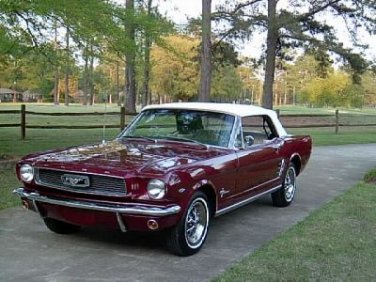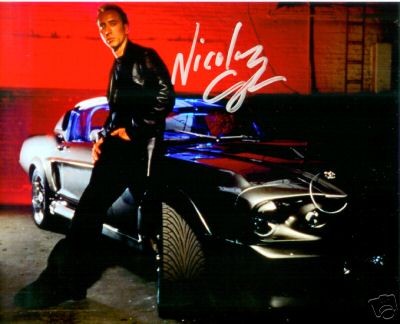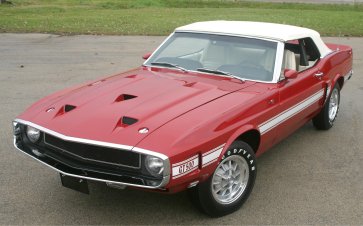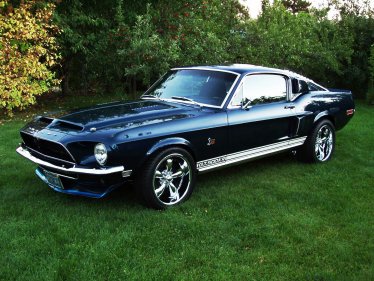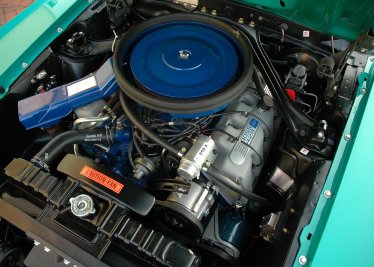






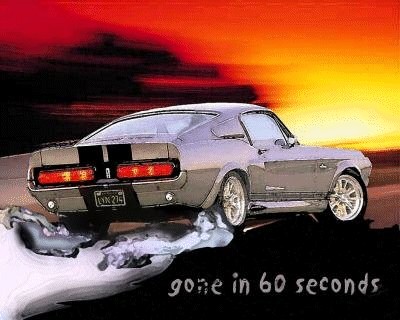
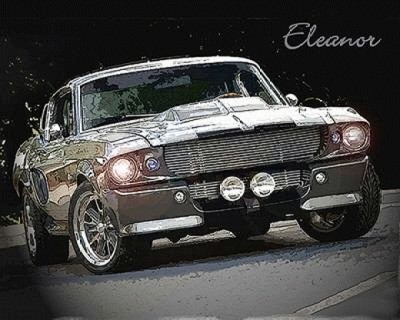
HOW TO DECODE YOUR VIN NUMBER ON YOUR 1964 1/2, 1965 OR 1966 FORD MUSTANG
OUR SAMPLE VIN NUMBER: 5R09A201258
5 - Designates the year the vehicle was assembled.
All 1964 and 1965 Mustangs begin with a "5", indicating 1965
Other years are as follows:
6 = 1966; 7 = 1967; 8 = 1968; 9 = 1969; 0 = 1970
R - Designates one of three assembly plants (there are F, R and T)
F = Dearborn, Michigan; R = San Jose, California; T = Metuchen, New Jersey
09 - Designates one of three body styles (there are 07, 08 and 09)
07 = Coupe; 08 = Convertible; 09 = Fastback
A - Designates one of seven engines used
A = 289 4 V premium fuel
C = 289 2 V
K = 289 4 V high performance
T = 200 1 V 6 cylinder
U = 170 1V 6 cylinder (1964 1/2 Mustang only)
D = 289 4 V (1964 1/2 Mustang only)
F = 260 2 V (1964 1/2 Mustang only)
201258 - Designates the consecutive unit number
According to this number, this vehicle would have been the 201,258 unit rolling down the assembly line.
DECIPHERING THE CODE:
In summary, our VIN Number that we used as an example, tells us the following:
It is a 1965 Mustang that was manufactured in the San Jose, California assembly plant. It is a Fastback with an A Code 289 4 V premium fuel engine and was the 201,258 car assembled.
HOW TO DECODE YOUR VIN NUMBER ON YOUR 1967 OR 1968 FORD MUSTANG
Each letter or number in a Vehicle Identification Number, or VIN, stands for something. For the purpose of explaining each individual letter and number, we have created a sample VIN number. Then we have broken this VIN number down, explaining what each number and letter represent.
OUR SAMPLE VIN NUMBER: 7R02C114001
7 - Designates the year the vehicle was assembled.
7 = 1967; 8 = 1968; 9 = 1969; 0 = 1970
R - Designates one of three assembly plants (there are F, R and T)
F = Dearborn, Michigan; R = San Jose, California; T = Metuchen, New Jersey
02 - Designates one of three body styles (there are 01, 02 and 03)
01 = Coupe; 02 = Fastback; 03 = Convertible
C - Designates one of ten engines used
T = 200 1 V 6 cylinder
C = 289 2 V
A = 289 4 V
J = 302 4 V (1968 Mustang only)
K = 289 4 V high performance (1967 Mustang only)
S = 390 4 V
X = 390 2 V (experimental 1967 Mustang only)
Y = 390 2 V (1968 Mustang only)
W = 427 4 V (1968 Mustang only)
Q = 428 4 V CJ (1968 Mustang only)
114001 - Designates the consecutive unit number
According to this number, this vehicle would have been the 114,001 unit rolling down the assembly line.
DECIPHERING THE CODE:
In summary, our VIN number that we used as an example, tells us the following:
It is a 1967 Mustang that was manufactured in the San Jose, California assembly plant. It is a Fastback with a 289 2 V engine and was the 114,001 car assembled.
HOW TO DECODE YOUR VIN NUMBER ON YOUR 1969 OR 1970 FORD MUSTANG
Each letter or number in a Vehicle Identification Number, or VIN, stands for something. For the purpose of explaining each individual letter and number, we have created a sample VIN number. Then we have broken this VIN number down, explaining what each number and letter represent.
OUR SAMPLE VIN NUMBER: 9T03H194926
9 - Designates the year the vehicle was assembled.
9 = 1969; 0 = 1970
T - Designates one of three assembly plants (there are F, R and T)
F = Dearborn, Michigan; R = San Jose, California; T = Metuchen, New Jersey
03 - Designates one of three body styles (there are 01, 02, 03, 05)
01 = Coupe; 02 and 05 = Fastback; 03 = Convertible
H - Designates one of eleven engines used
T = 200 1 V 6 cylinder
L = 250 1 V 6 cylinder
G = 302 Boss
F = 302 2 V
H = 351 Windsor
H = 351 Windsor or Cleveland 2 V (1970 Mustang only)
M = 351 Cleveland 4 V
S = 390 4 V (1969 Mustang only)
R = 428 CJ
Q = 428 4 V CJ
Z = 429 4 V Boss
194926 - Designates the consecutive unit number
According to this number, this vehicle would have been the 194,926 unit rolling down the assembly line.
DECIPHERING THE CODE:
In summary, our VIN Number that we used as an example tells us the following:
It is a 1969 Mustang that was manufactured in the Metuchen, New Jersey assembly plant. It is a Convertible with a 351 Windsor and was the 194,926 car assembled.
HOW TO DECODE YOUR MUSTANG ENGINE BLOCK FOR A 1965, 1966, 1967, 1968, 1969 AND 1970 MUSTANG
Where to find the engine block numbers: look toward the back of the engine block on the right hand side, above the starter. You will find the casting number at this location.
For the purpose of explaining each individual letter and number, we have created a sample engine block number and date code. Then we have broken these numbers down, explaining what each number and letter represent.
OUR SAMPLE ENGINE BLOCK NUMBER: "C5AE-6015-E 7C20"
C - Designates the decade that the engine block was made.
C = 1960's; D = 1970's; E = 1980's and so on
5 - Designates the particular year that the engine block was made.
5 = 1965; 6 = 1966; 7 = 1967; 8 = 1968; 9 = 1969; 0 = 1970
It is important to note: a more accurate date of when the engine was made is reflected in the date code which follows the casting number. Casting numbers were sometimes a year or two ahead of the block's date of manufacture (sometimes they were even behind the date of manufacture).
This is evident, for example, in a 1964 1/2 Mustang with a 289. The casting number "C5AE-6015-E" and the date code "4D17" show differing years of the engine block's manufacture date. One might think that "C5" indicates the engine block was made in 1965. However, according to the date code, it was actually manufactured in 1964. Always look to the date code for the correct manufacture date.
A = Designates the vehicle the engine was designed for.
A = Galaxie; D = Falcon; F = made outside the USA; G = Comet; J = Industrial/Marine; M = Mercury; O = Fairlane; P = Autolite or Motorcraft; R = Rotunda; S = Thunderbird; T = Truck; V = Lincoln; Z = Mustang
E = an engineering number used by Ford
(The 289 was originally designed for the Ford Galaxie and the letters AE stayed on the engine block number even after other models were added to the lineup)
6015 = Designates an engineering number used by Ford. "6015" meant "289 Engine Block"
E = Designates the location that the engine block was made. Engine blocks were made in Detroit, Michigan and Windsor, Canada
The next set of numbers, "7C20", indicate the date code. In this example, even though the casting number reads "C5", it doesn't mean that the engine was made in 1965. You would need to look at this date code to see when it was made, which in this case is 1967.
Breaking the "7C20" date code down:
7 = designates the particular year that the engine block was made (remember to look at this date code for an accurate reading of the engine block's manufacture date)
5 = 1965; 6 = 1966; 7 = 1967; 8 = 1968; 9 = 1969; 0 = 1970
C = designates the month that the engine block was made
A = January; B = February; C = March; D = April; E = May; F = June; G = July; H = August; J = September; K = October; L = November; M = December
(the alphabet letter "I" was not used in the sequence)
20 = Designates the day of the month
DECIPHERING THE CODE:
In summary, our engine block sample number "C5AE-6015-E 7C20" tells us the following:
At first glance, one might think that this is a 1965 Galaxie 289 engine block. However, according to the date code, this engine block is a 289 block made on March 20, 1967.
Ideally, you would want the engine block date code to be 2 - 6 weeks BEFORE your car's build date. If you had a car that was built June 1, 1965 and you found an engine block with a date code of 5E10, which is May 10, 1965, this would be a match made in heaven!
WHAT IS THE DIFFERENCE BETWEEN A 1964 1/2 MUSTANG AND A 1965 MUSTANG ?
There actually aren't any Mustangs that are stamped "1964". They all carry a "5" in the VIN number, designating a "1965". Mustang Coupe and Convertible production began in April 1964. It is still unclear as to exactly when Fastback production started, but it appears to be sometime in the summer of 1964.
The first Coupes and Convertibles that were manufactured had the engine codes C, D, F, K or U. When the early D, F and U engines were being phased out, the Fastback production was just beginning.
As the first Fastbacks rolled down the assembly line, some may have been outfitted with the last remaining early engines available. Therefore, the first Fastbacks may have had engine codes D, F or U. As production continued and these early engines ran out, engines with codes A, C, K and T were used. The K code engine was available from 1964 up until 1967.
It can be difficult to prove a true 1964 1/2 Mustang, but any early Mustang with a D, F or U engine code is definitely a 1964 1/2 Mustang. Mustangs with engine codes A or T are considered 1965's. Mustangs with the C or K code engine option could be either a 1964 1/2 or a 1965 Mustang. It is important to check the build date on the door tag. This date gives further information as to when the car was assembled.
There is also a "gray area" when explaining the differences between 1964 1/2 and 1965 Mustangs. The very earliest 1965's could have some of the 1964 1/2 parts installed on them. These parts were put on 1965's until the parts were phased out, similar to the engines being phased out. Some of the unique characteristics of the first parts include the following:
" HEADLIGHT EXTENSIONS AND HOODS: The first manufactured headlight extensions had a beveled edge along the top. The front corners of the hood skin remained un-pinched around the hood frame. This un-pinched flange pointed straight down to fill a gap that was caused by the beveled headlight extension (1965 headlight extensions did not carry this beveled edge; therefore the hood skins were pinched).
" RADIATOR CORE SUPPORT: The first manufactured core supports had three long vertical slots near the battery (1965 core supports had four elongated oval slots).
" HORN STYLE AND MOUNTING LOCATION: The first manufactured Mustang horns were quite large and mounted down on the strut rod frame rails near the bottom inside corners of the radiator (1965 horns were considerably smaller and mounted on the core support near the top outside corners of the radiator).
" FASTBACK REAR INTERIOR STEEL TRIM: The first manufactured Fastback rear trim wrapped around the interior's fiberglass panels. This steel trim extended from under the rear window, around the fiberglass interior panels and stopped about 1 1/2 inches short of the door glass (1965 steel trim extended all the way to the door glass).
" AUTOMATIC TRANSMISSION SHIFTER HANDLE: The first manufactured AT shifter handles were quite small (1965 AT shifter handles are the same shape, but about 50% larger than the early ones).
" PASSENGER SEAT: The first manufactured passenger seats were not adjustable to move forward or backward. There was not any sliding track mechanism on the mounting hardware (1965 passenger seats had full front to rear sliding adjustment).
" SHORT CARPET: The first manufactured carpet did not climb up the rocker panel. It stopped at the rocker and had an embroidered edge. The rocker was then covered with vinyl to match the interior (1965 carpet climbed up the rocker panel and was covered by the door sill plate).
" FLOOR PAN: The first manufactured floor pans had staggered seat belt mounting holes along the transmission tunnel for the front seats. The passenger seatbelt mounting hole was the furthest forward to accommodate the non-adjusting seat. These floor pans were not immediately phased out. I actually have mid-year 1965 Mustangs with staggered holes (Most mid-year and later 1965 floor pans had evenly spaced seatbelt mounting holes).
" SEAT RISERS: The first manufactured seat risers had a large oval cutout in the center. (1965 seat risers had a solid top).
These are some of the differences that we have found. We hope you have enjoyed reading this. If you have found this guide to be helpful, please indicate by voting "YES" below.
Mustang CHEERS to you!
Be sure to check out other Mustang Guides for additional restoration information and helpful tips.
FastbackStack, LLC provides the hard-to-find, obsolete Mustang parts for your Classic 1964 1/2 - 1970 Mustang restorations. With over 100,000 items (most of which still need to be listed on eBay), we offer what no one else has! We love hearing from fellow Mustang enthusiasts and would like to extend a special invitation to you to join our exclusive group of those receiving helpful Mustang restoration tips, those learning about our newly listed RARE, ORIGINAL parts, and those receiving money saving specials.




